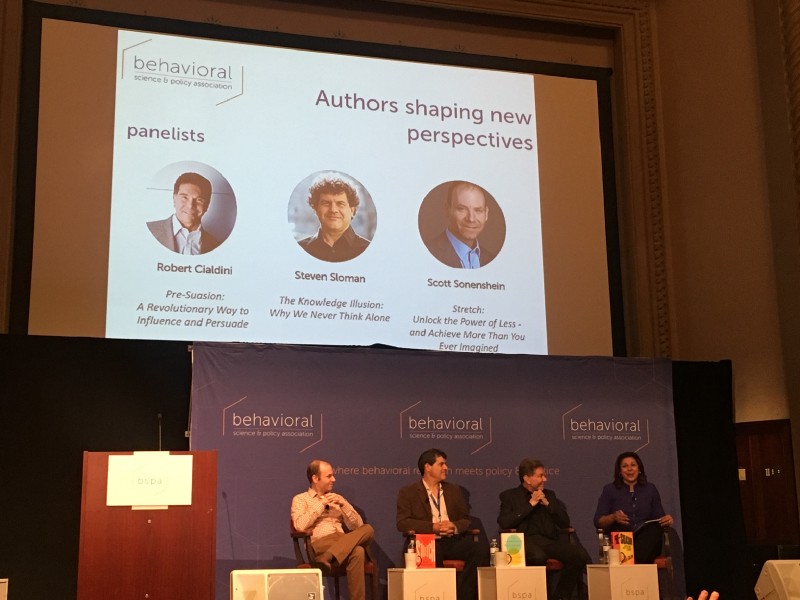
We recently attend BSPA 2017, Behavioral Science and Policy Association’s conference in New York City. It’s an annual convening of policymakers, practitioners and scientists to brainstorm research best practices and topic areas within behavioral science. If you didn’t go, read below for a dose of FOMO.
1) Ask for a colleague’s advice, not her opinion, when asking for feedback on a project.
This insight comes from Robert Cialdini, author of Pre-Suasion: A Revolutionary Way to Influence and Persuade. In his book, he cites a 2011 study in which people were asked to give advice or an opinion on a restaurant concept. Those who were asked for advice were subsequently more likely to say they would eat there. In a similar vein, asking a colleague for advice could help her feel more bought into the project and therefore more willing to help with it. Cialdini explained it as a difference between psychologically taking a step forward in the case of advice, and taking a step back in the case of opinions.
2) Show people information in a way that is most relevant to them: MPG is not a good metric, for example.
Rick Larrick shared his research that shows that miles per gallon is not the best metric for encouraging the purchase more fuel efficient cars. It’s not a linear metric: the difference between going from 10 MPG to 20 MPG saves 500 gallons over 10K miles, whereas going from 20 MPG to 50 MPG saves 300 gallons over 10K miles. In consumer-speak, we should really be emphasizing how much gas is saved, not miles per gallon. That’s what the consumer cares about, it’s easier for him to understand; therefore, it’s more likely to actually influence his behavior.
This is only one example — what metrics do you use in your industry and are they relevant to how a consumer thinks?
3) Friction matters.
Any barrier to taking action will most likely decrease conversion to that action — it’s why “barriers” made it as one of our 3B’s in our framework to behavior change. Time and again this has shown to be true. Here is a compelling example of it in action:
In a 529 study with 1000 Boston families (2017 Long and Bettinger), there were 3 conditions: 1) People attended an informational workshop on 529 plans 2) People got assistance with the signup process for a 529 plan 3) People got assistance with the signup process for a 529 plan and $50 to start. In the first condition, 0.98% signed up, In the second, sign up increased to 2.4%. How about the third? A whopping 24.7% signed up — providing help with a small starting amount is the winning combo by far.
4) Give the specific percentage of agreement to emphasize consensus.
Many times people don’t agree with us. When this happens, how do we convince people that we’re right? There are many techniques, of course, but a compelling one is showing that there is scientific consensus about our opinion. According to Derek Koehler, giving specific percentage is more powerful than a qualitative statement. In other words: “98% of scientific experts agree that climate change is real” vs. “experts generally believe climate change is real.” Unfortunately, the impact of showing a numerical summary can be undermined by “dueling experts” format that we see on so many news stations. This all-too-frequent format creates a false sense of balance.
5) Healthy eating interventions are not created equal: behavioral nudges work best.
Pierre Chandon completed a very nice analysis of healthy eating nudges that included 78 field experiments, 4.1 million observations. He found that cognitive nudges such as red-yellow-green color labels had a small effect (SMD = .14). Affective nudges such as healthy eating prompts (“How about grabbing a piece of fruit?”) and sensory cues (attractive photos) had a small to moderate effect (SMD = .33). And behavioral nudges such as cutting fruit or reducing plate sizes won out with a moderate effect (SMD = .48).
6) It’s easier to influence unhealthy eating than healthy eating.
In the same meta analysis, nudges that influence healthy eating have a small effect (SMD = .29) whereas nudges that influence unhealthy eating have a moderate effect (SMD = .41). So if you’re in the health space, you may have more success getting people to put down that bag of potato chips than eat a salad. In some ways, this feels counterintuitive to us, but that’s the beauty of research — it can show us that our intuition is wrong.
7) National Security Professionals are applying behavioral insights in their work.
Representatives from the United States Air Force, Army, Marine Corps, and Navy spoke at the conference in a session moderated by Jenn Lerner and Captain Brad DeWees, sharing some of the ways they are turning to behavioral science to solve their problems, especially in increasing the diversity through de-biasing recruitment techniques. This was a special treat for those of in the field — to see real live applications of our work in a very important context. We look forward to hearing more from them as they have more details on their interventions and results.
Learn more about Irrational Labs’ Behavioral Economics Bootcamp.
